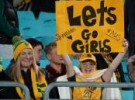Last weekend, electors in the seat once held by the reforming South Australian Labor premier Don Dunstan, showed his name could still shape history.
$0/
(min cost $0)
Login or signup to continue reading
Gentrification and boundary changes had placed his old seat, now called Dunstan, safely in Liberal hands, but now it is the state's first loss of an opposition electorate to a government in a byelection since 1908.
Despite acute cost-of-living pressures and an access crisis for ambulances at hospitals, the Opposition had failed to capitalise on what should have been straightforward.
Elsewhere that same night, the Liberal Party was receiving some, let's say, 'clarifying' feedback from Tasmanians in a state election expressly called to entrench a "strong, stable" majority.
While the badly wounded premier Jeremy Rockliff will limp on, he will be vulnerable to a resurgent right wing and faces an even bigger crossbench after securing just 13 or 14 seats in the 35-member House of Assembly.
Some common lessons are emerging.
In Adelaide, it suited both sides to say Labor wrested Dunstan from the opposition because Premier Peter Malinauskas is ascendent. Yet even accepting that a byelection haircut for a government is de rigueur, Labor's primary vote was anaemic at 32.1 per cent - down more than 3 per cent on its seat-losing return in 2022. The Liberal Party's first preference support also fell from 46.7 per cent to 43.5 per cent.
Most troubling for conservatives was that the disaffected turned up in a Greens' tally nudging towards 20 per cent - it had been tracking as high as 25 per cent before counting of pre-poll votes started.
Affluent voters in Adelaide's well-to-do inner-east moved away from the Liberals, but over Labor to get to the Greens much like some had in three federal Queensland seats in 2022 - a state with no prominent teal candidates.
So, what is going on? While preferential voting ameliorates the effects, voters appear to be shopping for purer forms of representation and are fleeing the left / right silos on which the major party duopoly has relied.
Elections now seem to be throwing up results in which the majors score a third each and the remainder goes to "others".
In the last federal election, Labor's primary vote - and remember, it won a parliamentary majority - was just 32.6 per cent.
There is no certainty that the erosion of once dominant blocs will end here either. One or both constellations may be headed for the exit in the next few cycles - at least as credible options for governing in their own right.
The numbers before and after 2022 hint at that problem just as the preferment of well-chosen community independents points to the solution.
From the 2019 election, Scott Morrison's show emerged with 77 seats to Labor's 68. In 2022, the numbers basically reversed - Labor had 77 seats but the Coalition, just 58. The balance went to a dramatically expanded crossbench. Mostly by elevating progressive women over conservative men.
It seems likely that 2022 will be looked back on as the passing of the post-war stability in parliamentary composition and of the default Australian norm of single party majorities.
Of course, the immediate story from May 2022, aside from the change of government itself, was the gutting of the Liberal heartland by articulate community candidates of genuine substance - Kooyong, Wentworth, Curtin, Goldstein, North Sydney, and Mackellar. These built on previous successes in Mayo, Indi, and most spectacularly, Tony Abbott's Warringah stronghold in 2019.
Others such as Higgins and Boothby fell to Labor. It is worth noting that all the seats named here are now held by mid-career professional women, all tertiary-educated, and all broadly reflective of community attitudes on education, health, climate, parliamentary reform, and gender fairness.
Contrasting their positioning with the recalcitrance of the party they displaced is instructive.
Just days before the Dunstan byelection, the infamous enmities of the SA Liberals came crashing into voters' news feeds when a little-known radical-conservative senator Alex Antic, replaced the moderate Anne Ruston at the prized number 1 spot on the Liberals' Senate ticket.
The optics of relegating a senior frontbench woman behind a boastful backbench ideologue were abysmal even before the feverishly anti-woke Antic gloated that the "gender card" was "nothing but a grievance narrative".
Poised to vote, Dunstan voters gained a sobering glimpse of the antediluvian views in vogue within the SA Division of the Liberal Party.
In Hobart, similar toxicities were aired as the religious-right flexed its muscles placing men, including three ex-federal rejects - the arch-conservative monarchist Eric Abetz, Michael Ferguson, and Guy Barnett - at the top of the Liberal tickets in all five multi-member electorates. In addition, Rockliff had spent much of the campaign aggressively attacking Jacqui Lambie Network candidates and now needs her support to guarantee confidence and supply.
Earlier this month, the NSW division boldly chose International Women's Day to name its office-holders.
Charlotte Mortlock, a former journalist now running a network to promote Liberal women, summarised the result: "Yesterday, on IWD, the NSW Liberal Party voted on our state executive. We didn't get a single woman up. We now have: a male federal leader. A male NSW leader. A male NSW Director. A male NSW president. And four male Vice Presidents," she tweeted on May 9.
One party at least seems to relish an excursion to the electoral fringes.
Mark Kenny is The Canberra Times' political analyst and a professor at the ANU's Australian Studies Institute. He hosts the Democracy Sausage podcast. He writes a column every Sunday.
Mark Kenny is The Canberra Times' political analyst and a professor at the ANU's Australian Studies Institute. He hosts the Democracy Sausage podcast. He writes a column every Sunday.





















 Toi Staff
Toi Staff Gideon Levy
Gideon Levy Belen Fernandez
Belen Fernandez Andrew Mitrovica
Andrew Mitrovica Mort Laitner
Mort Laitner Rami G Khouri
Rami G Khouri Ali Fathollah-Nejad
Ali Fathollah-Nejad Nikkei Editorial
Nikkei Editorial
